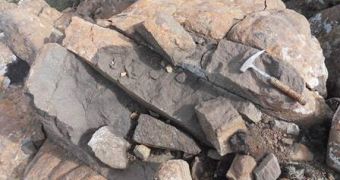The angular rock formations in Drakensburg, i.e. the highest mountain range in Southern Africa, might not have come into being as a result of cold temperatures in this region alone.
On the contrary, researchers at Wits University now say that, according to their investigations, it is possible that mountain landscapes in this part of the world were largely shaped by lightning strikes.
The scientists argue that, when a rock is hit by lightning, it explodes and takes an angular form such as the one pictured next to this article.
They say that, as evidence suggests, this is precisely what happened to several summits in this region.
The researchers base their claim on data collected while using a compass to pin down the magnetic field of rock formations in said mountain range.
Thus, the areas that got hit by lightning were the ones whose magnetic field did not correspond to the one recorded in their proximity.
“A compass needle always points to magnetic north. But when you pass a compass over a land’s surface, if the minerals in the rock have a strong enough magnetic field, the compass will read the magnetic field of the rock, which corresponds to when it was formed.”
“In the Drakensburg, there are a lot of basalt rocks which contain a lot of magnetic minerals, so they’ve got a very strong magnetic signal,” Professor Jasper Knight explains.
“The energy of the lightning hitting the land’s surface can, for a short time, partially melt the rock and when the rock cools down again, it takes on the magnetic imprint of today’s magnetic field, not the magnetic field of millions of years ago when the rock was originally formed,” the researcher goes on to detail.
After putting together a map of lightning strikes in Drakensburg, Professor Jasper Knight and his colleagues concluded that such phenomena greatly influenced the evolution of local landscapes.
Their findings challenge the assumption that mountains change shape over very long periods, and that they do so only under the influence of climatic conditions.
“Many people have considered mountains to be pretty passive agents, just sitting there to be affected by cold climates over these long periods of time.”
“This evidence suggests that that is completely wrong. African mountain landscapes sometimes evolve very quickly and very dramatically over short periods of time. These are actually very sensitive environments and we need to know more about them,” Professors Jasper Knight and Stefan Grab wish to stress.

 14 DAY TRIAL //
14 DAY TRIAL //